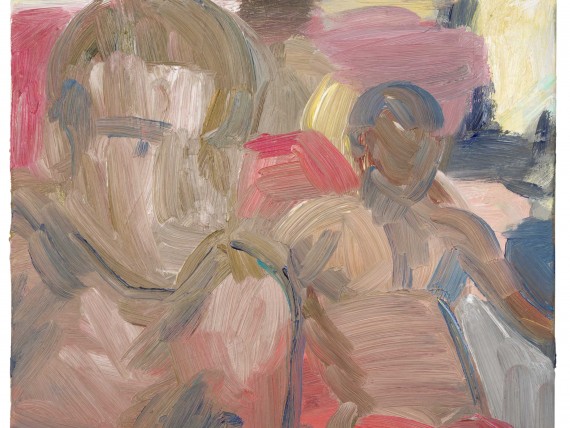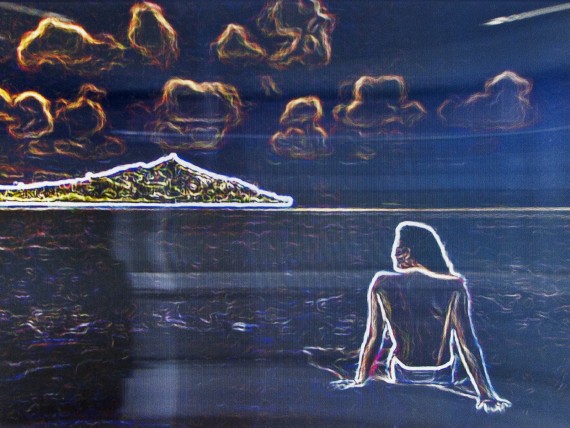Category: Top 10 — Published:
Electronic Superhighway (2016-1966) explores the intersections of art and technology over 50 years of dramatic change, through 100 works of art by over 70 artists and collectives. Join our journey back through time, art and the internet, and read about 10 key works selected by curator Omar Kholeif from the exhibition.
Snowbunny / Lakes (2015)
1920×1080 H.264/MPEG-4 Part 10 looped digital file (from 11 lossless TIF masters), media player, 70” flatscreen, armature, various cables
Arcangel’s work seeks to interpret and evaluate the technologies prevalent in today’s society. Snowbunny / Lakes (2015) is from a series of screen-based works consisting of pop culture images digitally manipulated to appear with a rippling ‘lake’ effect. Created using a Java applet, a small Internet-based program which uses the Java programming language, the effect was prevalent on personal websites in the late 90s but has been rarely used since and has dated over time.
Deep Face (2015)
Acrylic on B&W photograph, mounted on diabond
Coupland’s large-scale monochrome head shots show facial features obscured by brightly coloured painted abstract shapes or geometric patterns reminiscent of pixels or redactions. The series is underpinned by the technological developments in Facebook allowing the use of facial recognition software, with or without user consent. Coupland is a Canadian novelist, visual artist and designer. His first novel was the 90s best-seller Generation X: Tales for an Accelerated Culture and his works synthesize high and low culture, web technology, religion, and changes in human existence caused by modern technologies.
Homo Sacer (2014)
Digital video, perspex, rear projection 7:05, dimensions variable
This installation by artist, writer, publisher and technologist James Bridle consists of one of the projected ‘holograms’ increasingly found in airports, railway stations and government buildings to deliver instructions, give directions or offer help. The female hologram figure in Homo Sacer (2014) speaks lines from UK, EU and UN legislation, as well as quotations from government ministers. Her script describes the nature of citizenship in the 21st century, and how it can be revoked with potentially fatal consequences.

Aldo and Jesi, Albania, 16th August 2014 (2014)
Oil on canvas
Celia Hampton’s expressive, painted portraits explore how the Internet mediates sexual encounters, desire and portrayal. Her portraits take the form of nude close-ups of her subjects, rendered in broad brushstrokes and bathed in warm colours. Her models are friends and acquaintances, as well as anonymous figures culled from online communities such as chatroulette.com, a website connecting randomly selected individuals around the world via their webcams.

Glowing Edges_7.10 (2014)
Lenticular print, framed
Jennifer in Paradise was the first picture ever to be manipulated using Photoshop. Taken by one of the creators of Photoshop on holiday in the 80s, it depicts his girlfriend on a tropical beach. The photograph was digitized by Kodak in 1987 and supplied with the program. Though synonymous with early versions of Photoshop, the image has since become harder to track down. In Dullaart’s series of prints he loops the image of Jennifer in Paradise though Photoshop’s diverse filters to create effects such as ‘Plastic Wrap’ and ‘Glowing Edges’.
Internet Dream (1994)
Video sculpture
Widely recognised as the ‘Father of Video Art’ Nam June Paik’s large body of work includes video sculptures, installations, performances, videotapes and television productions. He is attributed with coining the term ‘Electronic Superhighway’, an allegory for the networked highways of the Internet. An ambitious work constructed from multiple TV screens, Paik’s Internet Dream (1994), displays a constant stream of rapidly changing scenes to hypnotic effect. It illustrates his early awareness of society’s move towards information saturation, celebrating the constant expansion associated with shifts forward in technology.
Lorna (1979-1982)
Installation, Computer-based interactive installation
Over three decades Hershman Leeson has created works exploring identity, image culture, surveillance and the relationship between humans and machines. She often employs alter egos in her immersive media projects. The interactive installation Lorna (1979-1982) presents a female character that lives in her apartment without any outside contact. A domestic interior includes a television set – an important object in Lorna’s life and her only window to the world. Using the TV remote controller the viewer is invited to take the role of the protagonist to find logic in a labyrinth of scenes and unravel her story.
Homage à Béla Bartók (1978)
Silkscreen print after plotter drawing
Before her well-known use of computers to make work, Molnar had been applying a systematic approach to art making that was remarkably similar to that of a computer processor: what she called a ‘Machine Imaginaire’. Exploring the visual possibilities enabled by repetition, rules and procedures, which she would modify very slightly with each iteration of an image, Molnar soon utilised the computer in order to expedite her process. Homage à Béla Bartók (1978) is a silkcreen print after a computer plotter drawing in homage to the Hungarian composer. Bartók was one of the early founders of comparative musicology and ethnomusicology.
TRASK (1967)
Acrylic on board
Painter Ulla Wiggen is noted for a number of paintings she produced between 1963 and 1969, which all take the inner workings of electronic devices as a subject. With an interest in the composite elements of these complicated appliances, Wiggen’s detailed realist paintings combine the digital skeletons of motherboards with her own technological motifs, exploring the convergence of realism and abstraction exemplified by the machines themselves. Wiggen’s large scale painting TRASK (1967) draws on the first Swedish electronic computer BESK, programmed by Gunnar Hellström in 1965.
Experiments in Art and Technology (E.A.T.)
E.A.T. News. Volume 1
E.A.T. was an interdisciplinary group that advocated the collaboration between visual artists, programmers, engineers and other specialists. During the 1960s E.A.T. involved a roster of diverse artists including Andy Warhol, Yvonne Rainer, Robert Rauschenberg, Jasper Johns and John Cage. The experimental outputs of E.A.T. can be seen as an early manifestation of the collaborative art practices we see today encompassing hacking, software, research and development. A range of archival materials, including manifestos, photos, and films from early experiments by the group are included in the exhibition.
Electronic Superhighway (2016-1966) runs from 29 January to 15 May 2016. As part of Electronic Superhighway Season, Whitechapel Gallery presents free commissions, displays and screenings, alongside talks, events and live performances.
The full list of artists included in Electronic Superhighway (2016-1966) are:
Jacob Appelbaum / Cory Arcangel / Roy Ascott / Jeremy Bailey / Judith Barry / Wafaa Bilal / Zach Blas / Olaf Breuning / James Bridle / Heath Bunting / Bureau of Inverse / Technology (B.I.T.) / Antoine Catala / Aristarkh Chernyshev / Petra Cortright / Vuk Ćosić / Douglas Coupland / CTG (Computer Technique Group) / Cybernetic Serendipity / Aleksandra Domanović / Constant Dullaart / Experiments in Art and Technology (E.A.T.) / Harun Farocki / Joana Hadjithomas and Khalil Joreige / Celia Hempton / Camille Henrot / Gary Hill / Ann Hirsch / Nancy Holt and Richard Serra / JODI / Eduardo Kac / Allan Kaprow / Hiroshi Kawano / Mahmoud Khaled / Oliver Laric / Jan Robert Leegte / Lynn Hershman Leeson / Olia Lialina /Tony Longson / Rafael Lozano-Hemmer / Jonas Lund / Jill Magid / Eva and Franco Mattes / Model Court / Vera Molnar / Mouchette (Martine Neddam) / Manfred Mohr / Jayson Musson / Frieder Nake / Joshua Nathanson / Katja Novitskova / Mendi + Keith Obadike / Albert Oehlen / Trevor Paglen / Nam June Paik / Jon Rafman / Evan Roth / Thomas Ruff / Alex Ruthner / Jacolby Satterwhite / Lillian F. Schwartz / Peter Sedgley / Taryn Simon / Frances Stark / Hito Steyerl / Sturtevant / Martine Syms / Thomson and Craighead / Ryan Trecartin / Amalia Ulman / Stan VanDerBeek / Steina and Woody Vasulka / Addie Wagenknecht / Lawrence Weiner / Ulla Wiggen / The Yes Men / YOUNG-HAE CHANG HEAVY INDUSTRIES